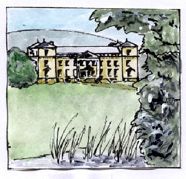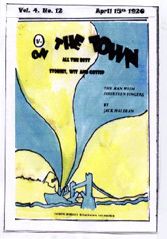Jack Haldean - A Brief Biography
 On December 14th 1903, Orville Wright, a young bicycle maker, achieved one of the longest-held dreams of man; he flew. That 12 second 120 foot long flight would change the world forever. It also radically changed the life of the young Jack Haldean.
On December 14th 1903, Orville Wright, a young bicycle maker, achieved one of the longest-held dreams of man; he flew. That 12 second 120 foot long flight would change the world forever. It also radically changed the life of the young Jack Haldean.
Jack, like many another young man, was desperate to fly, and the declaration of war on 4th August 1914 gave him an overpowering but achievable ambition. In 1915 the 16-year-old Jack, having conveniently “lost” his birth certificate, was accepted into the new service. His contemporary, Cecil Lewis, wrote “There was nothing in life to compare with wheeling away into the sky, trying turns, spirals, dives, stalls, gliding, zooming, doing all the stunts a pilot needs to give him confidence and nerves in a tight corner.”
Those nerves would serve Jack very well indeed, both in the air and on the ground.
He didn’t expect to survive the war; “There is no after-the-war for pilots,” Mick Mannock, the air ace declared and it was with very mixed feelings Jack contemplated the world on the 12th November 1918. With the end of the war his sense of purpose had been taken away and he felt lost. What he was suffering from – although he didn’t suspect it – was over-stretched nerves. The world had changed and all the old certainties had crumbled.
 He went to Hesperus in Sussex, the home of his Aunt Alice and Uncle Philip – the place he had always thought of as his real home – and there his cousin Isabelle suggested that he should turn his talent for writing into a profession, not so hard to do in that print-hungry world where magazines only had books and the cinema for competition. He had a brief flirtation with art, but it was as a writer he became known.
He went to Hesperus in Sussex, the home of his Aunt Alice and Uncle Philip – the place he had always thought of as his real home – and there his cousin Isabelle suggested that he should turn his talent for writing into a profession, not so hard to do in that print-hungry world where magazines only had books and the cinema for competition. He had a brief flirtation with art, but it was as a writer he became known.
Although his first stories usually had a flying background, he had a knack for detective stories. When an old friend, Ronnie Ledger, was accused of theft, Jack found the real culprit. Ronnie’s grateful uncle, who owned a string of magazines and weekly papers, suggested that Jack should join the editorial staff of On The Town. What this meant in effect was that Jack had a market for his work plus some irregular but solid work in the magazine offices.
 Then came the affair at Torrington Place. Jack had already met the officer in charge of the case, Inspector William Rackham, when he’d badgered the tolerant Rackham for details of police procedures to give verisimilitude to his short story
The Man With Fourteen Fingers.
Then came the affair at Torrington Place. Jack had already met the officer in charge of the case, Inspector William Rackham, when he’d badgered the tolerant Rackham for details of police procedures to give verisimilitude to his short story
The Man With Fourteen Fingers.
The young ex-pilot and the ex-infantry officer from Manchester hit it off. It was a few months later that Jack ran across the worried Rackham. Although strictly irregular, Rackham knew he could trust Jack and confided in him the details of the double murder which had gripped the press. By the simple observation that the county of Wiltshire has no coastline, he was able to put Rackham on the right lines that eventually led to the conviction of the man dubbed “The Mad Monk,” the vicar of St Ann’s.
The following summer Jack took up the invitation to spend a couple of weeks at Hesperus and help with the local Red Cross fete. What happened next is told in A Fęte Worse Than Death… and his life would never be the same again.

Site designed by Netaddress Ltd
Copyright © Dolores Gordon-Smith 2007
|


